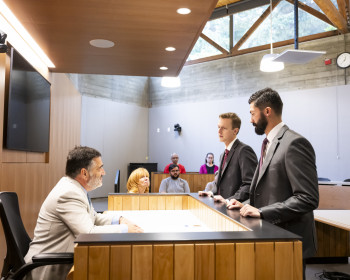Winds of Change Brings New Focus to Intersection of Nature and Energy Tech
Open gallery

As interest grows in offshore wind energy on the West Coast, the Green Energy Institute (GEI) at the law school hosted a webinar on February 23, 2022 to address questions about the associated opportunities and impacts. The Winds of Change: Offshore Wind, Fish, and the Western Grid was sponsored by the GEI and the Environmental, Natural Resources, and Energy Law program at Lewis & Clark Law School.
Elon Hasson ’01, renewable energy developer and GEI advisory council member, explored some of the benefits and challenges of offshore wind development on the West Coast with Himali Parmar, an expert in renewable integration and transmission congestion, and Dr. Andrew Gill, a fish behavioral ecologist focused on understanding how fish respond and adapt to renewable development.
The discussion was critically timed; two days later the Bureau of Ocean Energy Management (BOEM) announced three “Call Areas” for the development of floating offshore wind in federal waters off the Oregon coast. Per BOEM, “Call Areas” refers to areas designated as potential sites for offshore wind development, and the call was for formal public comment about the area, uses and concerns, and nominations of interest for development.
As Oregon is committed to producing 50% of its electricity from renewable resources by 2040, and now newly mandates Oregon’s two largest investor-owned utilities, serving 60% of the state, to provide Oregon consumers with 100% clean, carbon-free electricity by 2040, plans are being made to bring offshore wind to Oregon.
Ms. Parmar explained that wind energy, like most technological advancements, has traditionally carried higher capital costs, which create barriers to deployment. However, industry experts project those costs will decrease by almost half as the technological sophistication increases. Until that time, Federal support, generally in the form of tax incentives, is incredibly important for fiscal feasibility.
Additionally, although she noted a few transmission chokepoints on the grid, she also identified five coastal substations that can accommodate approximately 1.6GW of offshore wind capacity without any significant transmission upgrades. Ms. Parmar expressed optimism about the complementary benefits of offshore wind, which peaks in the late afternoon hours, to solar power. She reiterated Oregon’s “strong backbone grid” to accommodate the first tranche of offshore wind.
Outside of cost and transmission considerations, Dr. Gill highlighted several issues critical to evaluating environmental impacts of development. These include decisions around the location of wind energy sites–the distance to shore, the depth of the sites, the size of the cables running between the sites and the shore, and where the sites join the state’s power grid, as well as how each factor affects marine ecosystems and their inhabitants.
Dr. Gill underscored the need to understand the impacts of offshore wind in the context of other disciplines, such as policy, governance, state or national economics. He also issued a clarion call on the need for intersectional solutions. “We can’t do this independently, we need cross discipline, we need to think about collaboration and working together.”
The participants are all deeply committed to the success of offshore wind and renewable development. Mr. Hasson has focused on developing both wind and solar energy projects throughout the United States over the last decade. As the founder of Emerald Renewable Energy Developers, the company reflects his belief in holistic solutions that not only benefit the environment, but local communities and the people within them as well.
Ms. Parmar’s areas of focus are renewable integration, grid interconnection, production cost modeling, transmission congestion and losses, and their effect on locational power prices and asset valuation. She closely follows interconnection and transmission issues and proposed transmission plans across various power markets and performs independent assessments of reliability issues on the grid. Click here to read Ms. Parmar’s recent ICF white paper exploring the role of offshore wind development as a crucial part of California’s supply mix.
Dr. Gill’s current focus is on developing and leading initiatives into the decarbonization and sustainability agenda primarily through research of environmental and ecological interactions with offshore wind and marine renewable energy. He has specific expertise in understanding environmental effects of energy emissions into the sea on receptor species; this assists with cumulative ecological impact assessment for application to environmental risk and uncertainty. Click here to read Dr. Gill’s recent paper setting the context for offshore wind development effects on fish and fisheries.
To view the program in its entirety, click here.
Law Communications is located in room 304 of Legal Research Center (LRC) on the law Campus.
MSC: 51
email jasbury@lclark.edu
voice 503-768-6605
Cell: 626-676-7923
Assistant Dean,
Communications and External Relations, Law School
Judy Asbury
Law Communications
Lewis & Clark Law School
10101 S. Terwilliger Boulevard MSC 51
Portland OR 97219

